
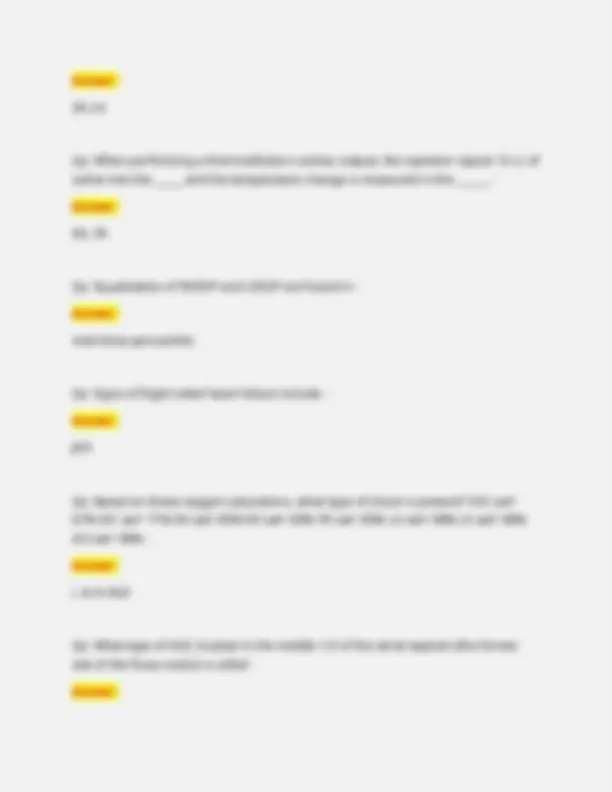
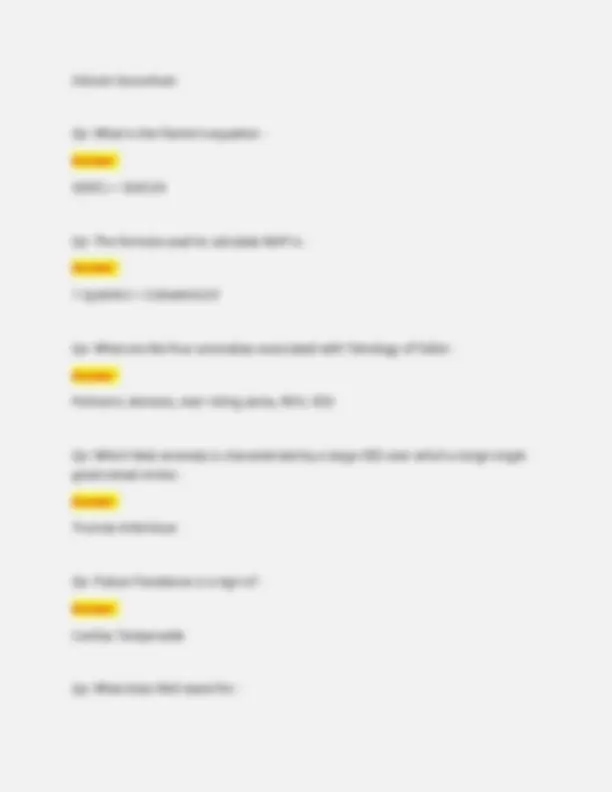
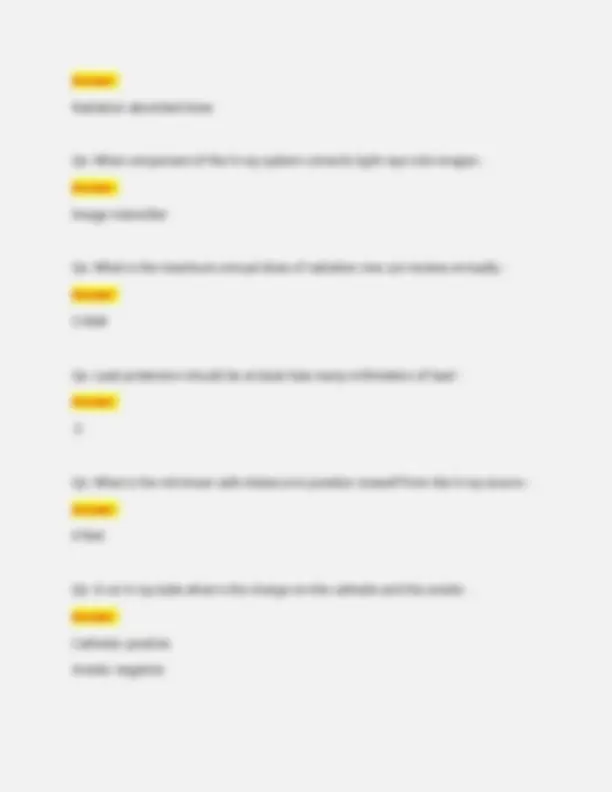
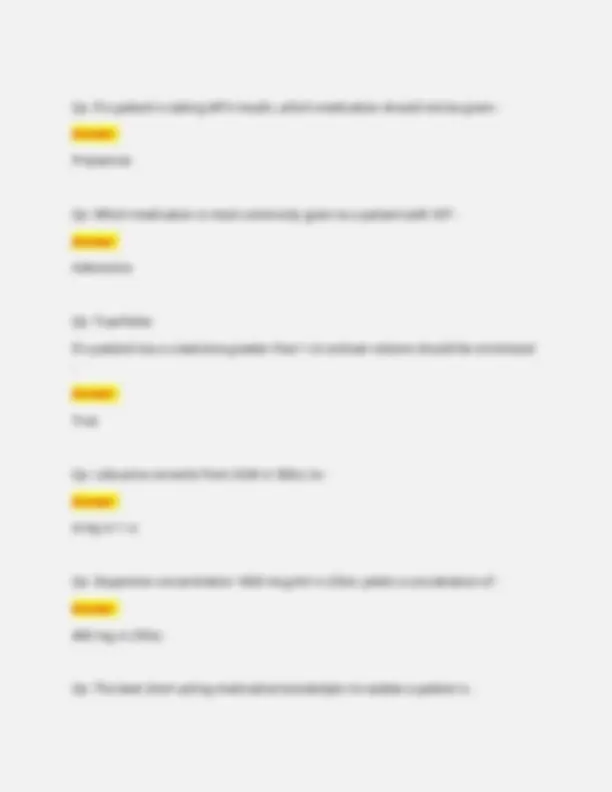
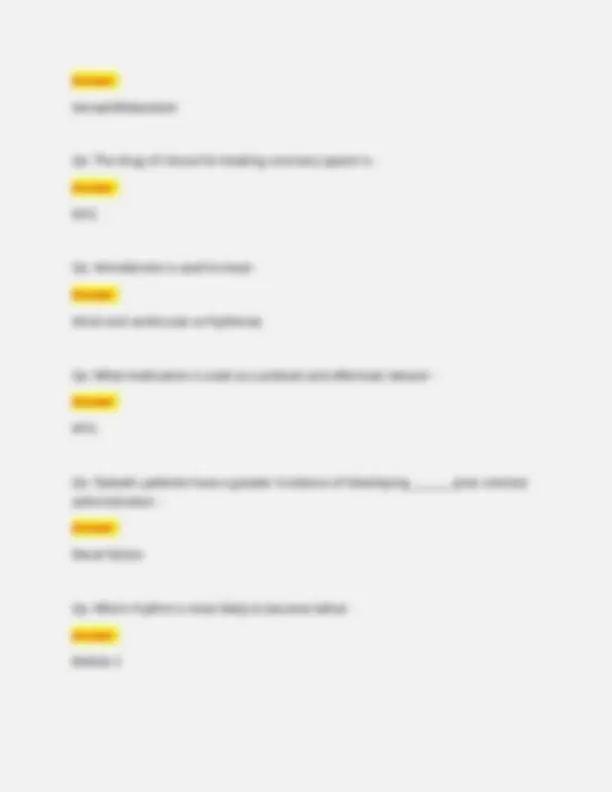
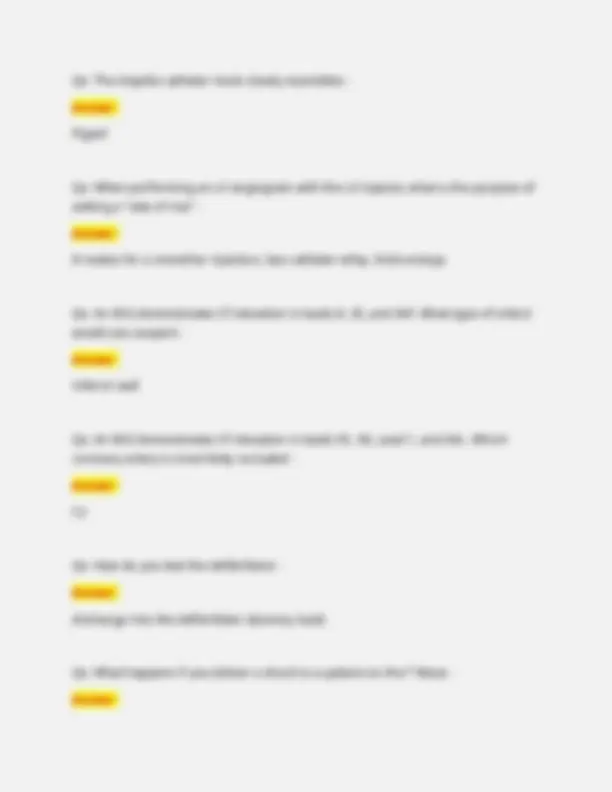
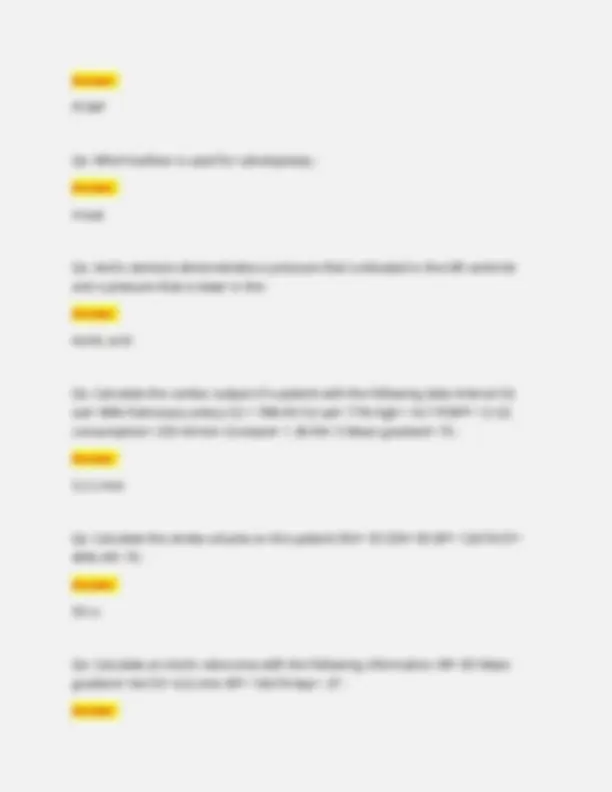
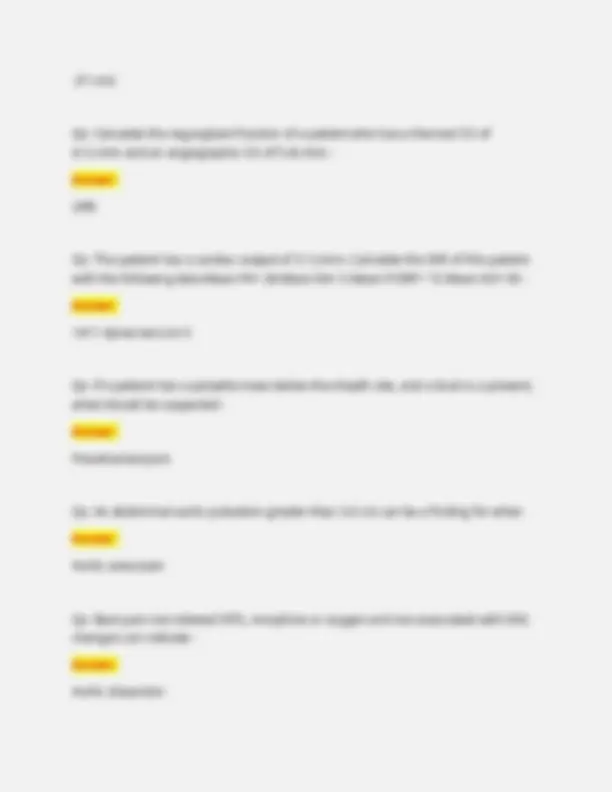
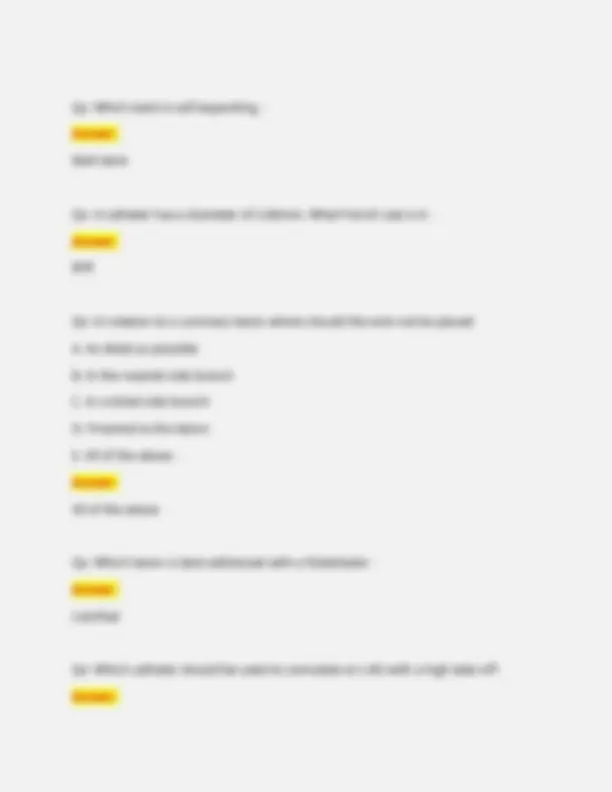
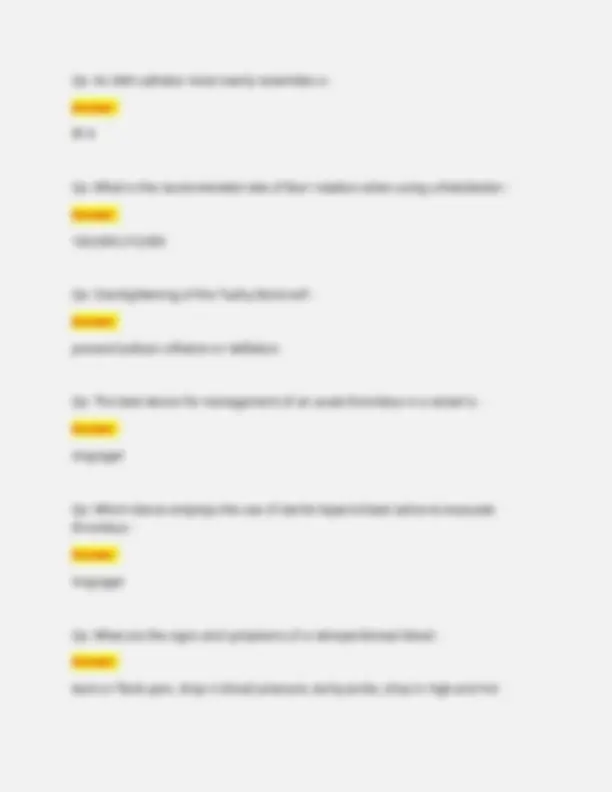
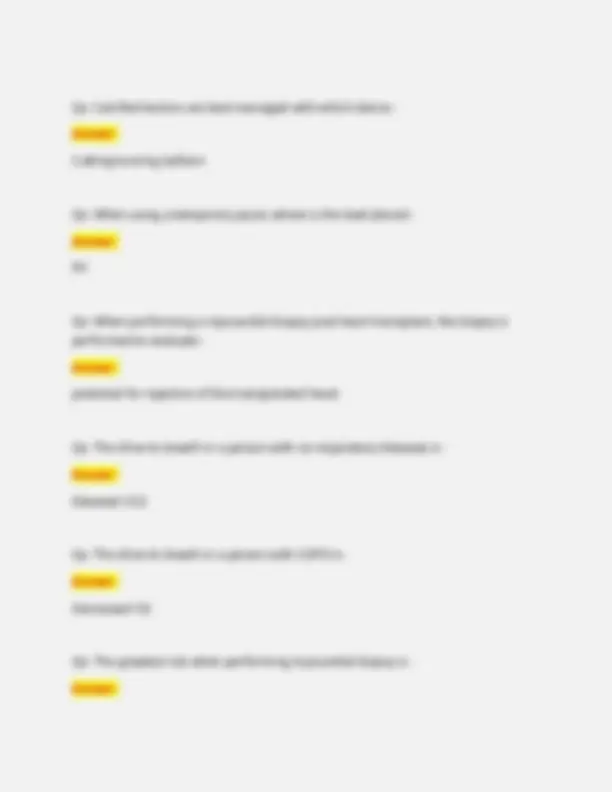
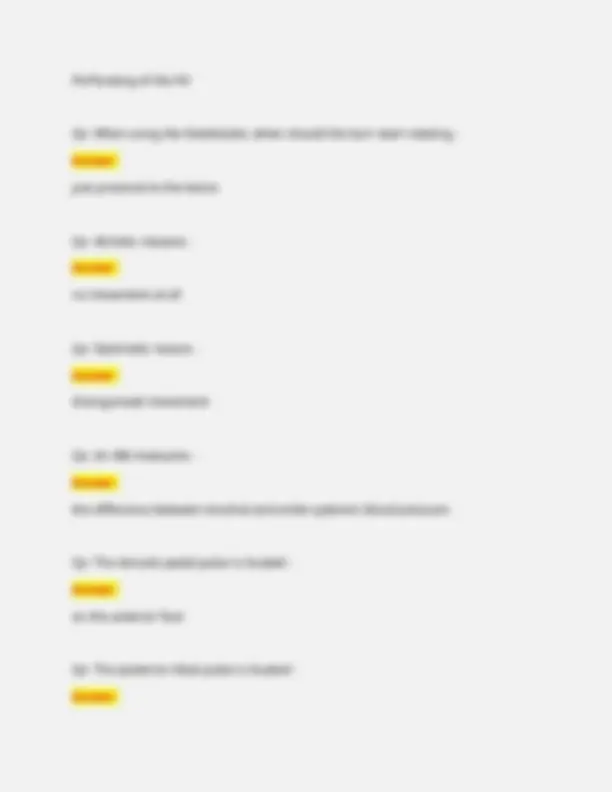
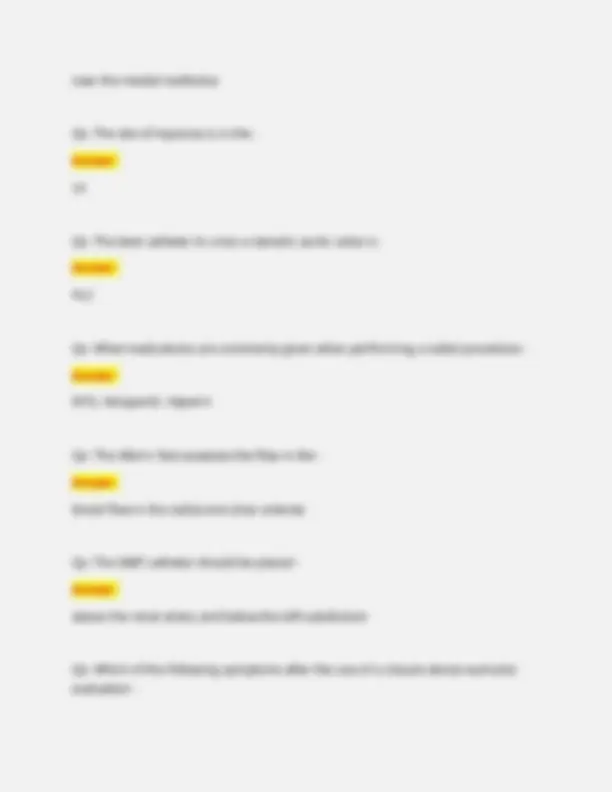
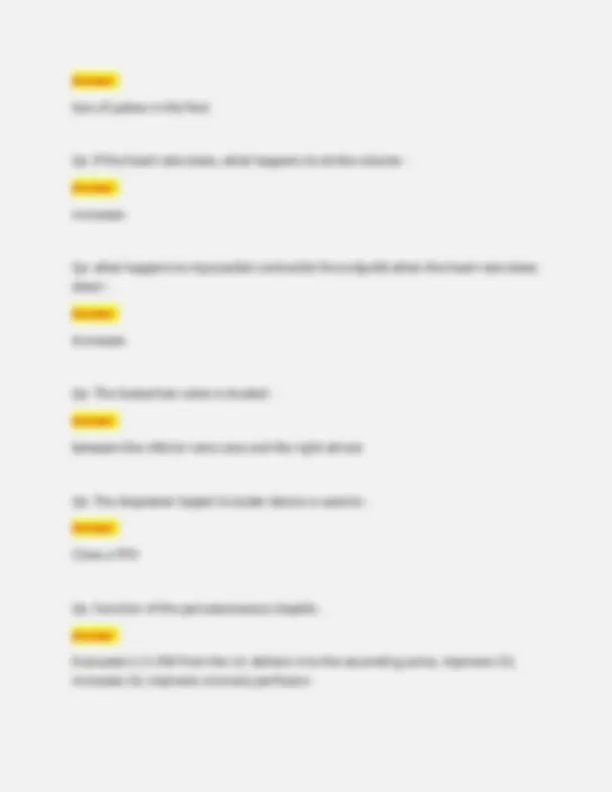
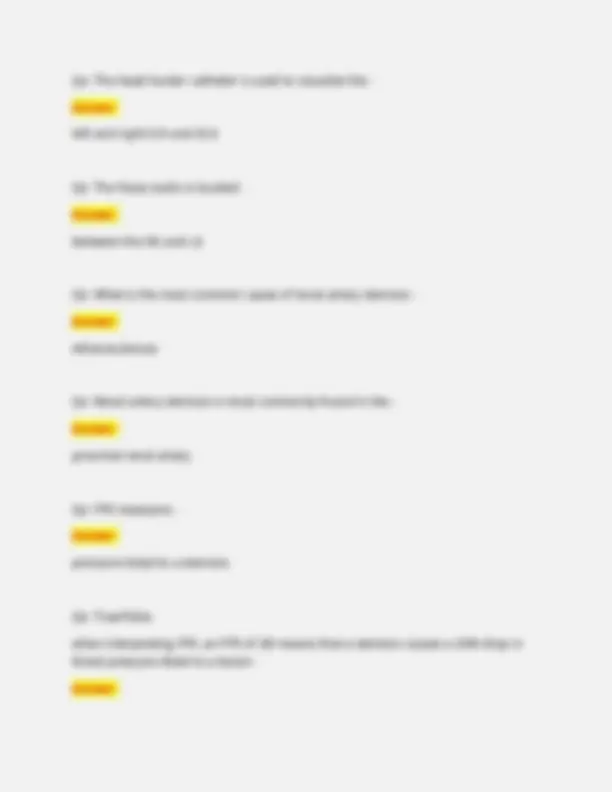
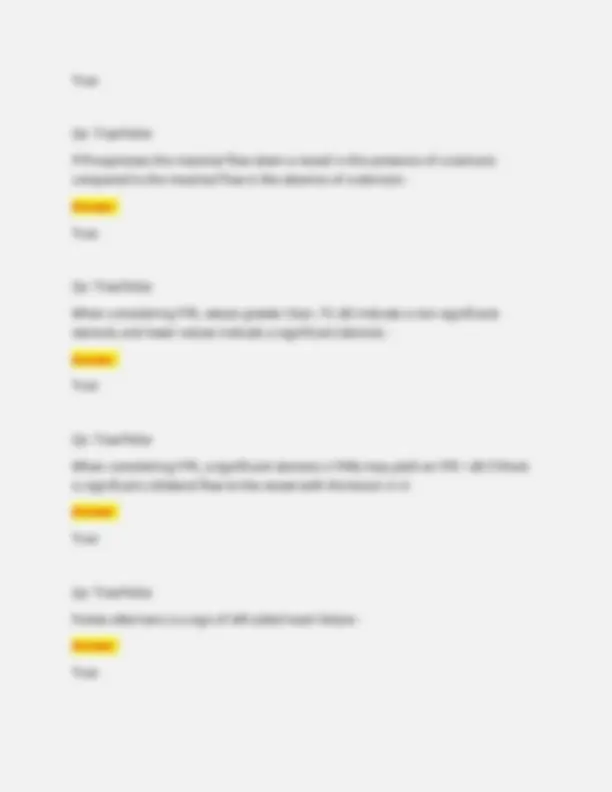
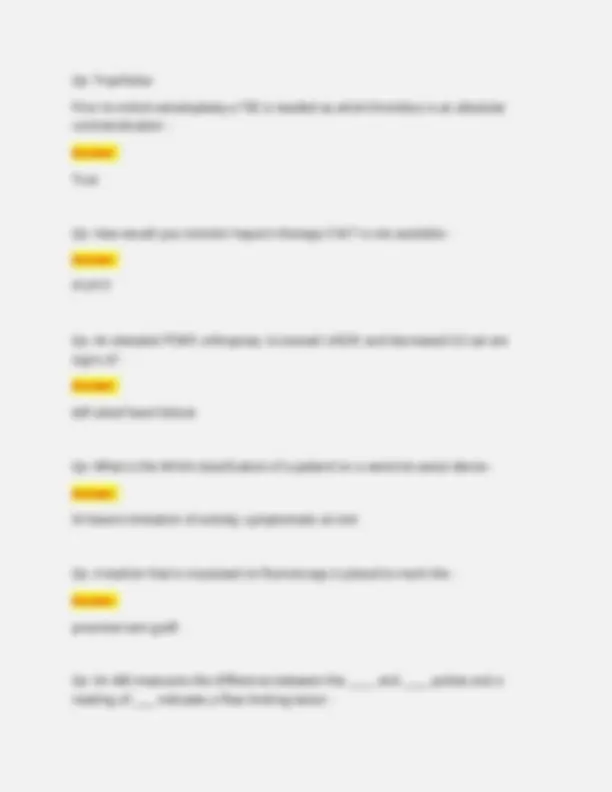
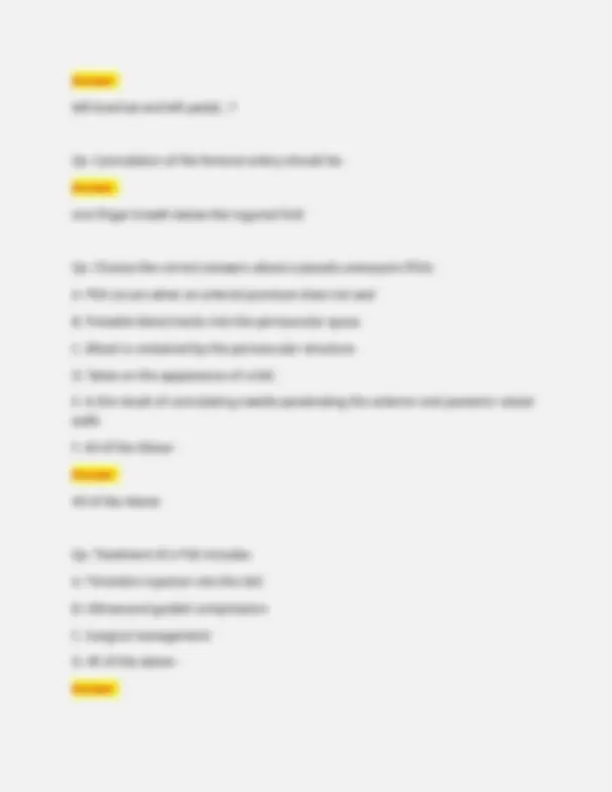
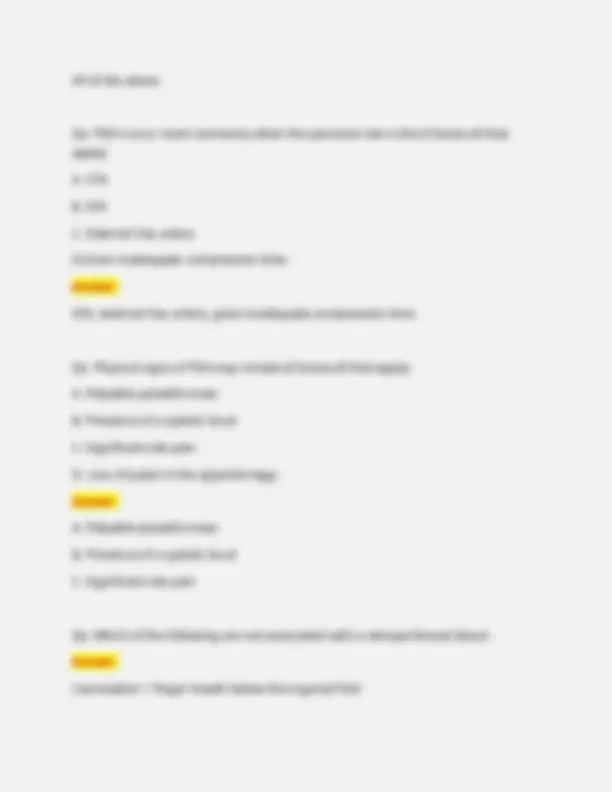
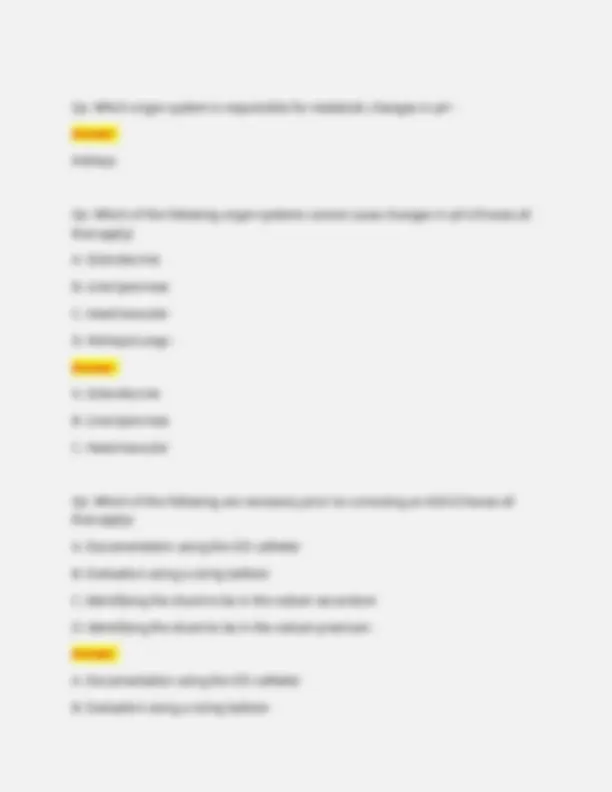
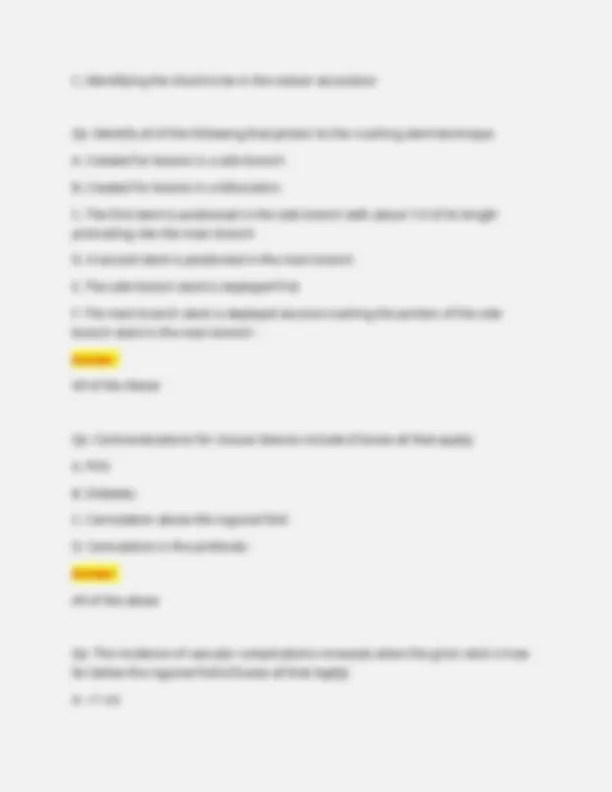
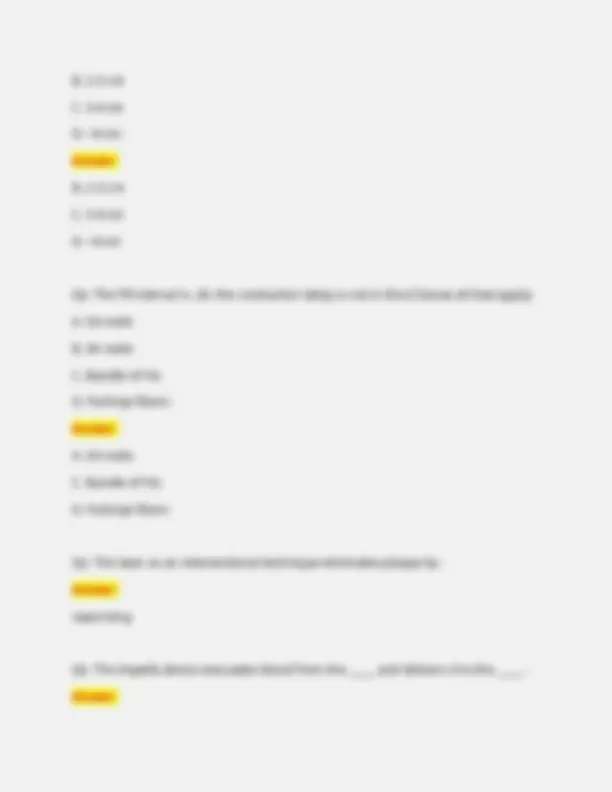
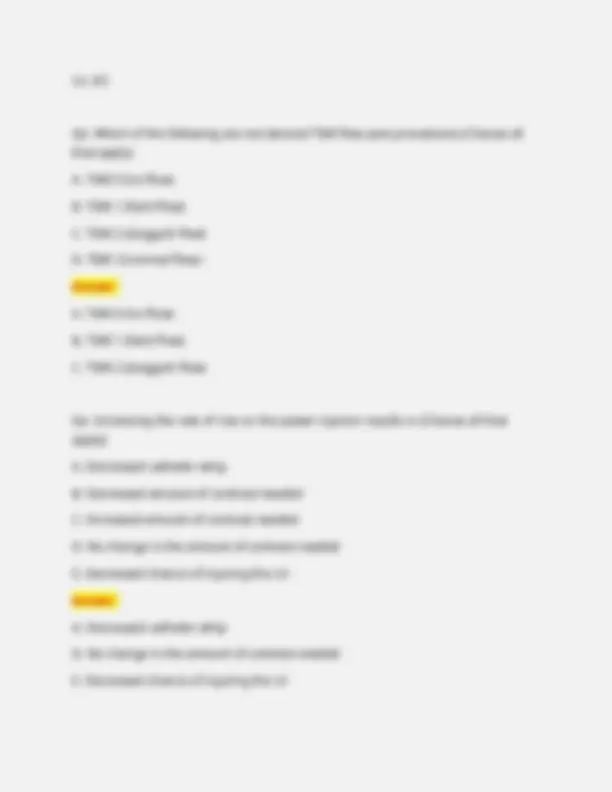
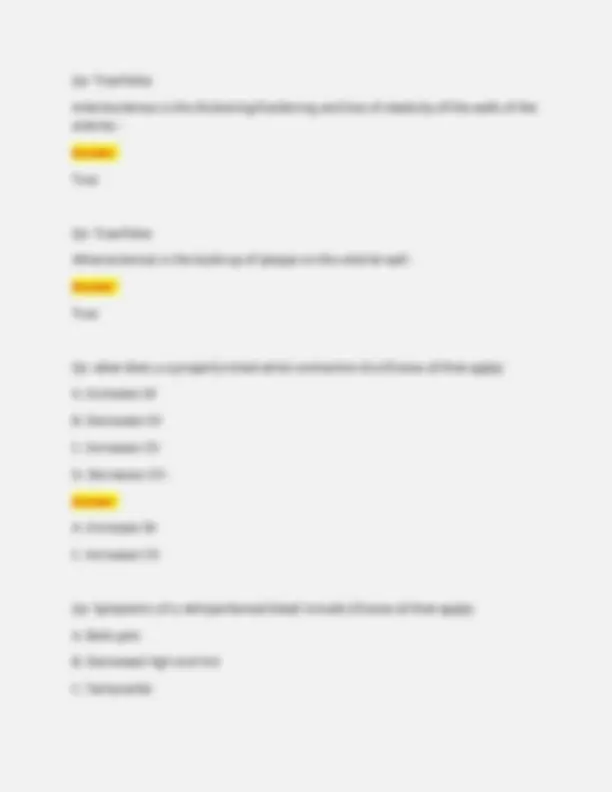
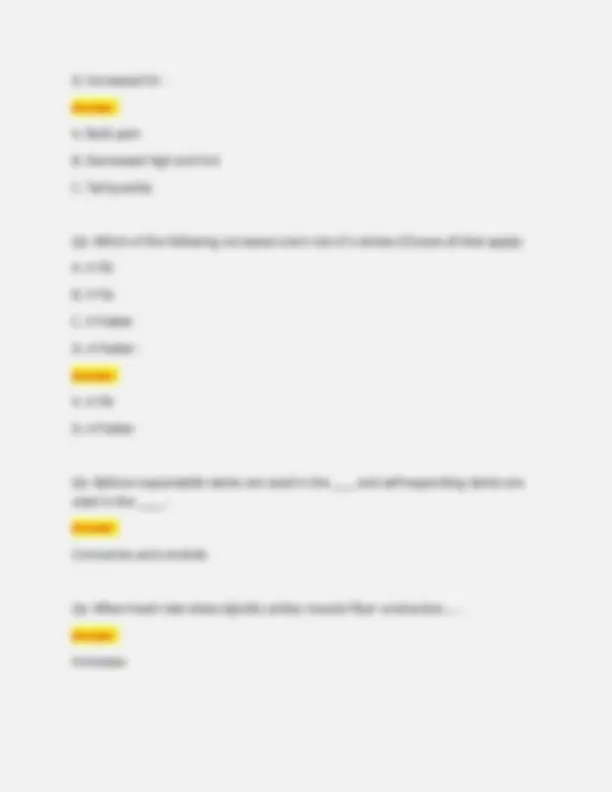
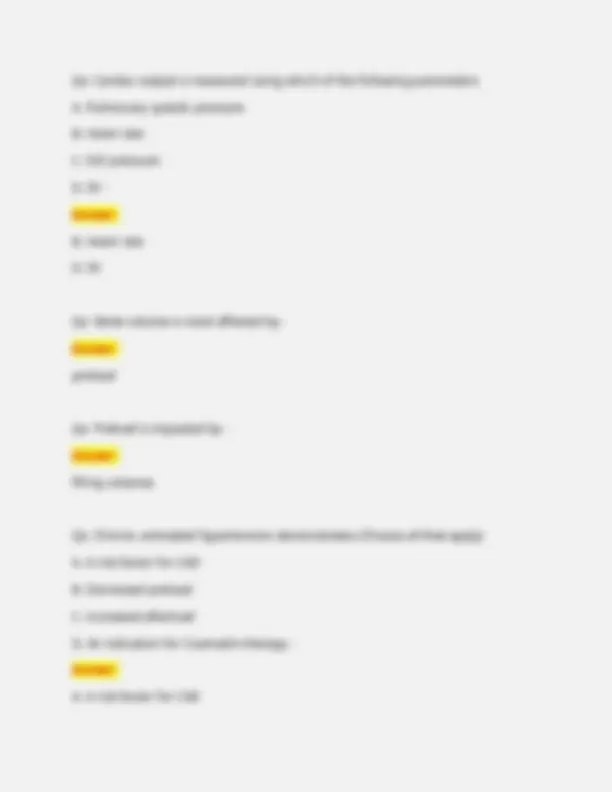
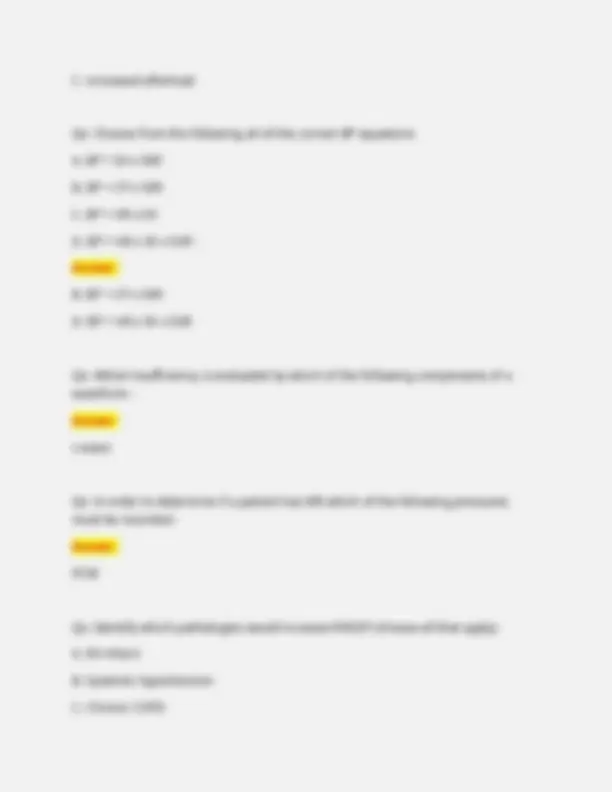
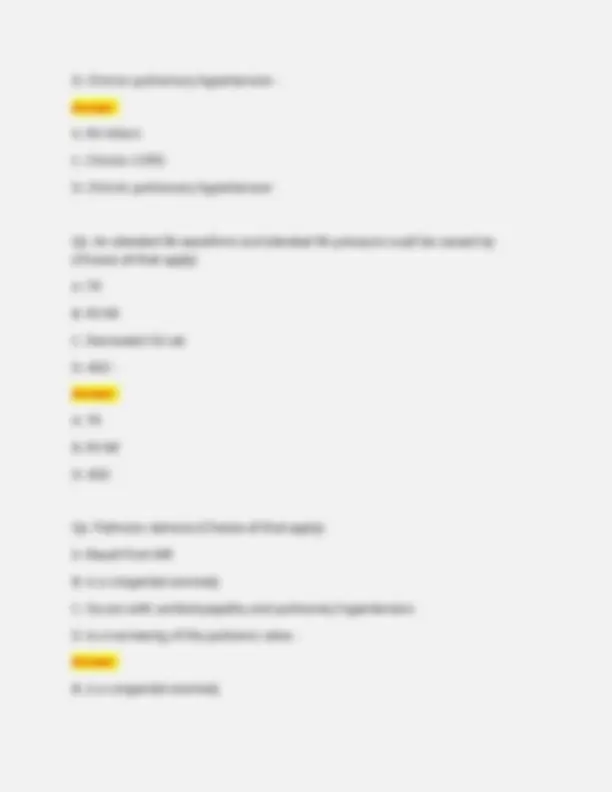
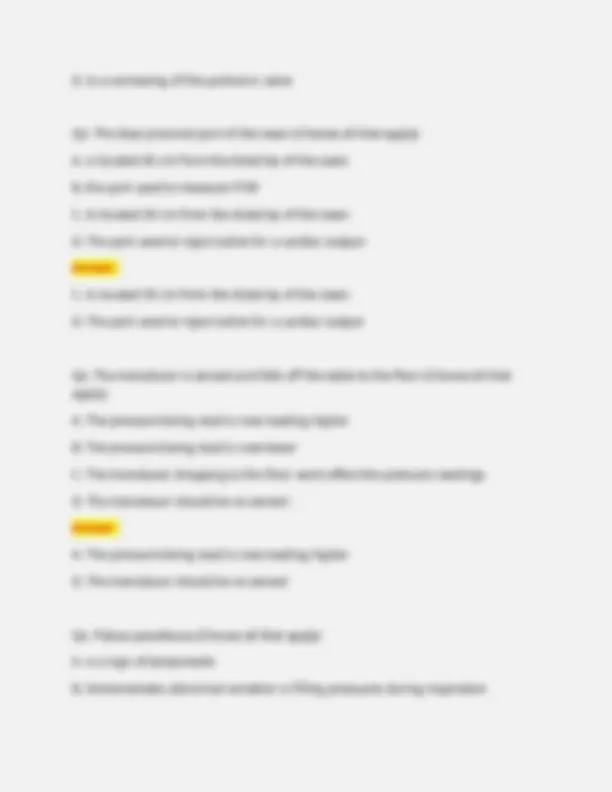
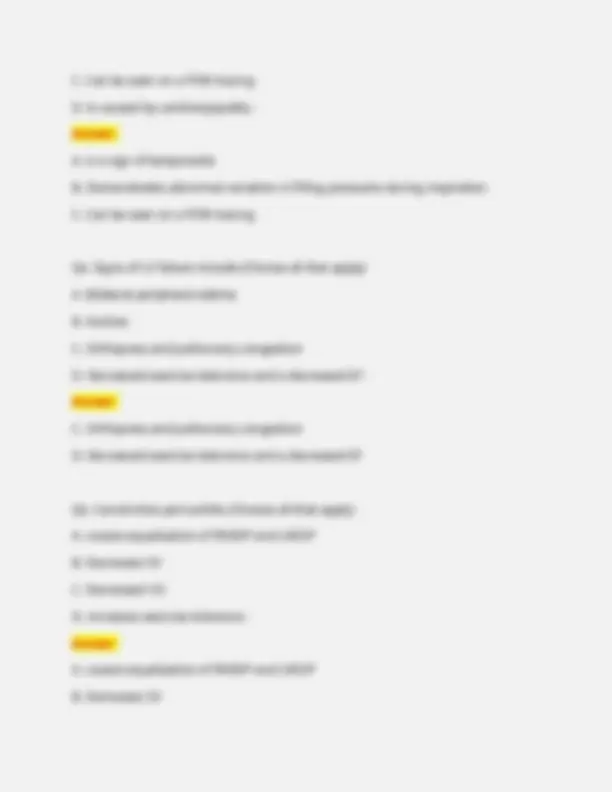
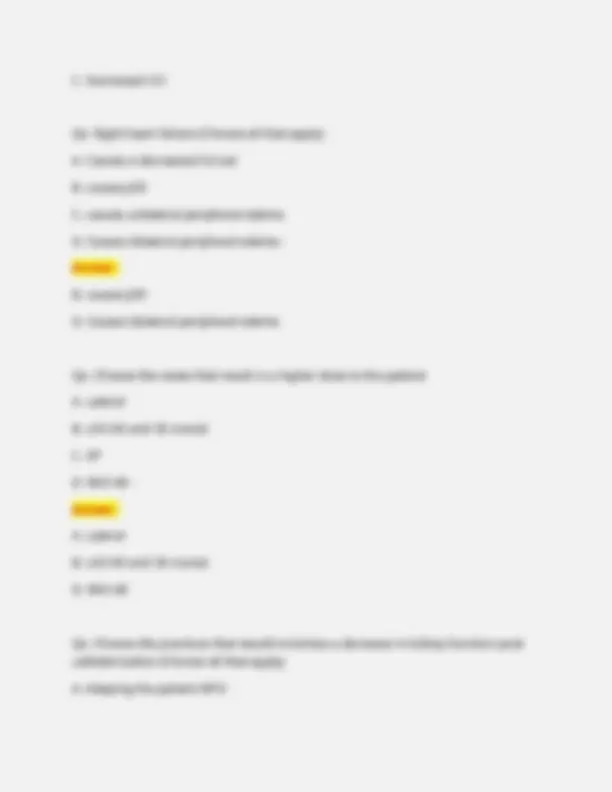
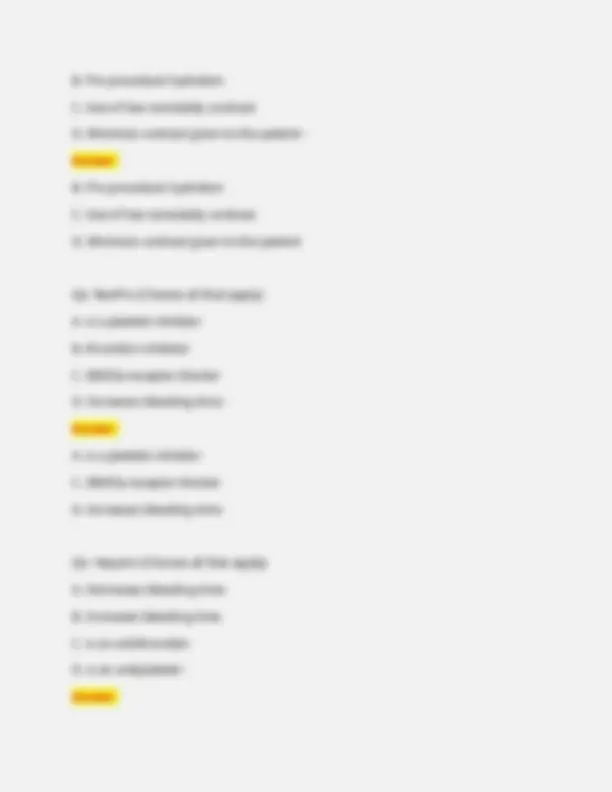

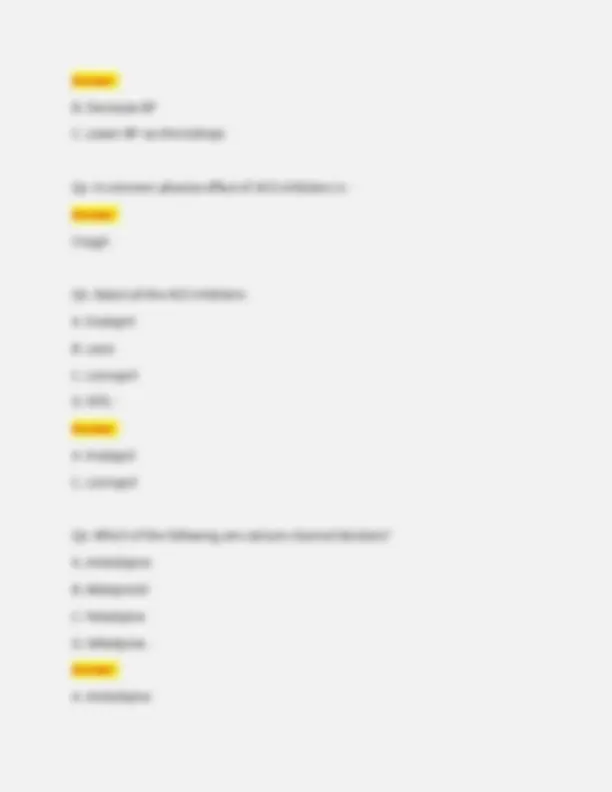
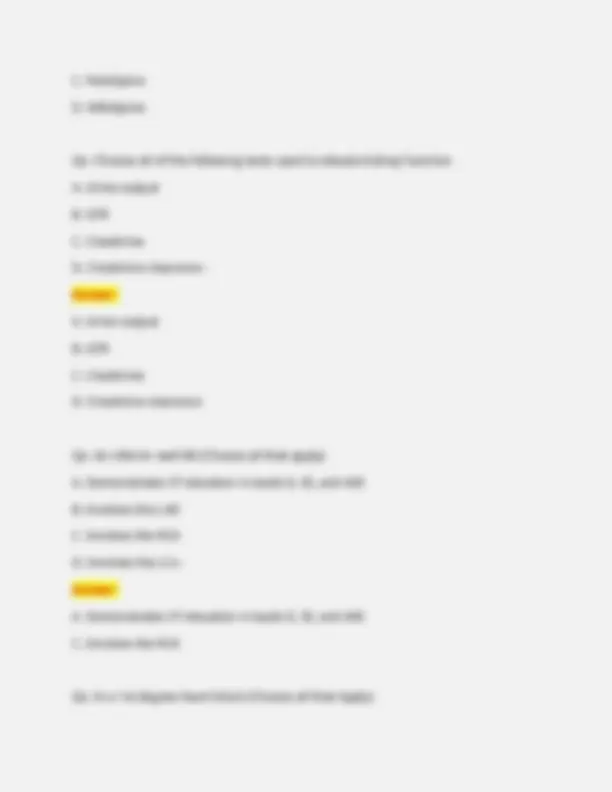
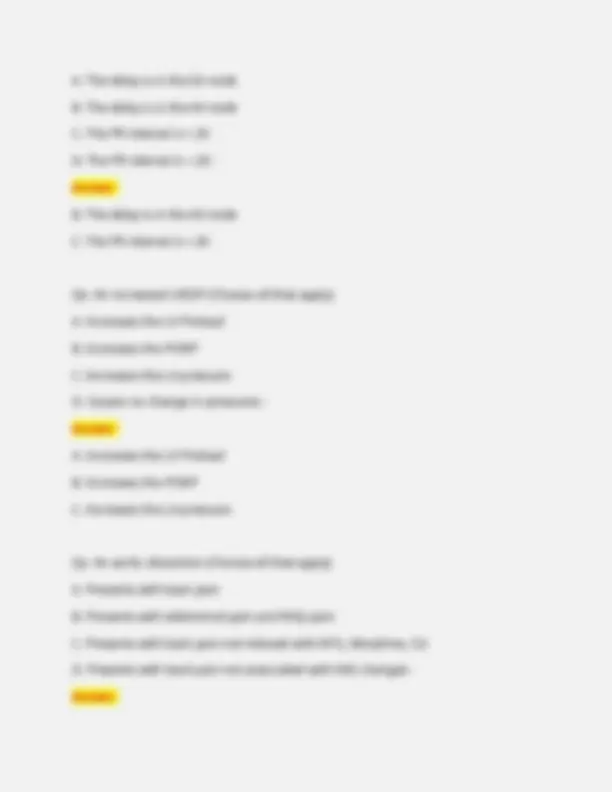
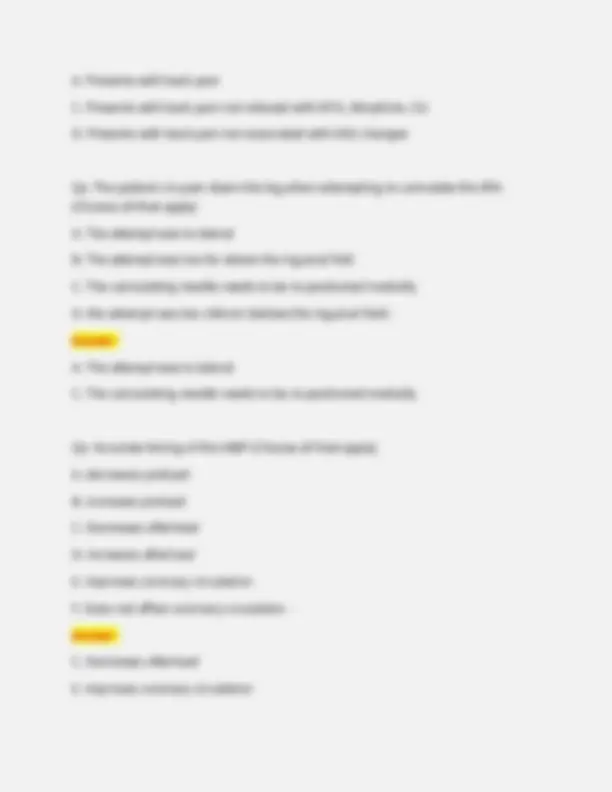
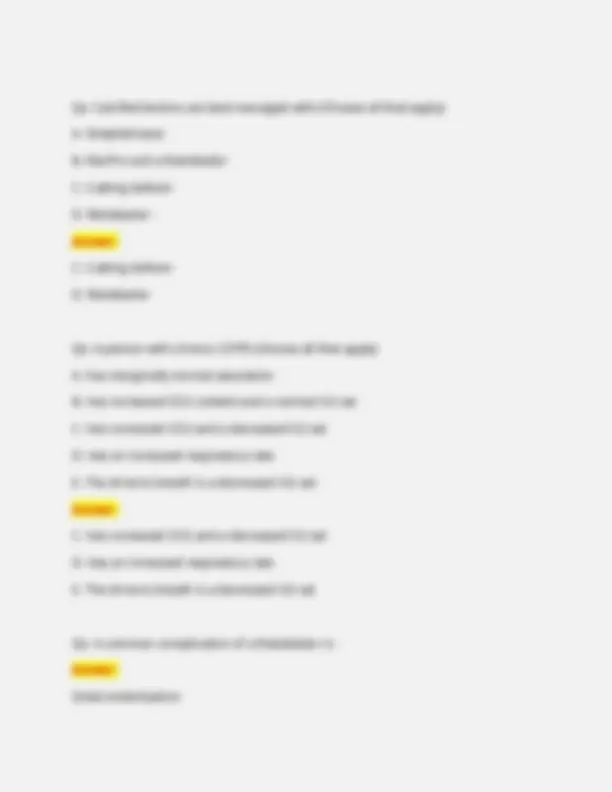



Study with the several resources on Docsity

Earn points by helping other students or get them with a premium plan


Prepare for your exams
Study with the several resources on Docsity

Earn points to download
Earn points by helping other students or get them with a premium plan
Community
Ask the community for help and clear up your study doubts
Discover the best universities in your country according to Docsity users
Free resources
Download our free guides on studying techniques, anxiety management strategies, and thesis advice from Docsity tutors
A series of practice questions and answers related to cardiovascular physiology and hemodynamics, focusing on key concepts such as cardiac output, stroke volume, blood pressure regulation, and various cardiac pathologies. It covers essential formulas, diagnostic findings, and treatment approaches relevant to cardiac care. The material is designed to reinforce understanding of cardiac function and related clinical scenarios, making it a valuable resource for students and professionals in cardiology and related fields. This resource is useful for exam preparation and quick review of critical concepts in cardiology. It includes questions on ekg interpretation, cardiac catheterization, and pharmacological interventions.
Typology: Exams
1 / 47

This page cannot be seen from the preview
Don't miss anything!








































What is the formula for calculating cardiac output? - Answer: CO= HR x SV Qs: What is stroke volume related to? - Answer: preload Qs: Preload is most impacted by..... - Answer: Increased filling volumes Qs: A patient with chronic untreated hypertension would demonstrate.... - Answer: Increased afterload Qs: Vascular resistance/pressure is most influenced by.... - Answer: Radius of the vessel
Qs: The formula for BP is.... - Answer: BP = CO x SVR Qs: What component of a Pulmonary Capillary Wedge pressure indicates Mitral insufficiency - Answer: V wave Qs: An elevated RVEDP is found in which pathology - Answer: RV infarct Qs: If the RA waveform is 2x the normal value, where would this be demonstrated in the physical assessment - Answer: JVD Qs: What is the most common cause of Pulmonic stenosis - Answer: Congenital Qs: The Blue proximal part of the swan is located how far from the distal tip of the swan -
Ostium Secundum Qs: What is the Flamm's equation - Answer: 3(SVC) + 1(IVC)/ Qs: The formula used to calculate MAP is - Answer: 1 (systolic) + 2 (diastolic)/ Qs: What are the four anomalies associated with Tetralogy of Fallot - Answer: Pulmonic stenosis, over riding aorta, RVH, VSD Qs: Which fetal anomaly is characterized by a large VSD over which a large single great vessel arises - Answer: Truncas Arteriosus Qs: Pulsus Paradoxus is a sign of - Answer: Cardiac Tamponade Qs: What does RAD stand for -
Answer: Radiation absorbed dose Qs: What component of the X-ray system converts light rays into images - Answer: Image intensifier Qs: What is the maximum annual dose of radiation one can receive annually - Answer: 5 REM Qs: Lead protection should be at least how many millimeters of lead - Answer: . Qs: What is the minimum safe distance to position oneself from the X-ray source - Answer: 6 feet Qs: In an X-ray tube what is the charge on the cathode and the anode - Answer: Cathode: positive Anode: negative
Qs: Heparin potentiates the action of - Answer: Antithrombin Qs: Fibrinogen is converted to Fibrin by the action of - Answer: Thrombin Qs: There are _________ known pathways to imitate the clotting cascade - Answer: 2 Qs: Aspirin inhibits the action of - Answer: Arachidonic Acid Qs: Which agent is not an antiplatelet - Answer: Heparin Qs: If a patient has diabetes and renal failure with a creatinine of 2.0 what would you give - Answer: fluids to hydrate
Qs: If a patient is taking NPH insulin, which medication should not be given - Answer: Protamine Qs: Which medication is most commonly given to a patient with SVT - Answer: Adenosine Qs: True/False If a patient has a creatinine greater than 1.4 contrast volume should be minimized
Answer: True Qs: Lidocaine converts from 2GM in 500cc to - Answer: 4 mg in 1 cc Qs: Dopamine concentration 1600 mcg/ml in 250cc yields a concetration of - Answer: 400 mg in 250cc Qs: The best short acting medication/anxietolytic to sedate a patient is -
Qs: The Impella catheter most closely resembles - Answer: Pigtail Qs: When performing an LV angiogram with the LV injector, what is the purpose of setting a "rate of rise" - Answer: It makes for a smoother injection, less catheter whip, limits ectopy Qs: An EKG demonstrates ST elevation in leads II, III, and AVF. What type of infarct would you suspect - Answer: inferior wall Qs: An EKG demonstrates ST elevation in leads V5, V6, Lead 1, and AVL. Which coronary artery is most likely occluded - Answer: Cx Qs: How do you test the defibrillator - Answer: discharge into the defibrillator (dummy load) Qs: What happens if you deliver a shock to a patient on the T Wave - Answer:
You could put them into Vfib Qs: In 1st degree heart block, where is the conductive delay - Answer: AV node Qs: What is the normal PR interval - Answer: .12-. Qs: If a patient is attached to the monitor, V tach is rhythm, the patient has no pulse and is not responding, what should you do - Answer: Unsymchronized cardioversion Qs: If a patient is on a monitor in SVT, SBP is 70, the patient is diaphoretic, dusky and SOB. What should you do - Answer: Do immediate synchronized cardioversion Qs: A common complication of placing a pacing electrode/wire is - Answer: Perforation/Preicardial Effusion/Tamponade
Answer: PCWP Qs: Which balloon is used for valvuloplasty - Answer: inoue Qs: Aortic stenosis demonstrates a pressure that is elevated in the left ventricle and a pressure that is lower in the - Answer: Aortic arch Qs: Calculate the cardiac output of a patient with the following data Arterial O sat= 98% Pulmonary artery O2 = 74% RV O2 sat= 71% Hgb= 14.7 PCWP= 12 O consumption= 250 ml/min Constant= 1.36 RA= 5 Mean gradient= 70 - Answer: 5.2 L/min Qs: Calculate the stroke volume on this patient ESV= 35 EDV= 85 BP= 120/74 EF= 40% HR= 70 - Answer: 50 cc Qs: Calculate an Aortic valve area with the following information HR= 85 Mean gradient= 64 CO= 4.2L/min BP= 136/74 Sep= .37 - Answer:
.37 cm Qs: Calculate the regurgitant fraction of a patient who has a thermal CO of 4.1L/min and an angiographic CO of 5.4L/min - Answer: 24% Qs: This patient has a cardiac output of 5.1L/min. Calculate the SVR of this patient with the following data Mean PA= 24 Mean RA= 5 Mean PCWP= 15 Mean AO= 95 - Answer: 1411 dynec/sec/cm- Qs: If a patient has a pulsatile mass below the sheath site, and a bruit is a present, what should be suspected - Answer: Pseudoaneurysm Qs: An abdominal aortic pulsation greater than 3.0 cm can be a finding for what - Answer: Aortic aneurysm Qs: Back pain not relieved NTG, morphine or oxygen and not associated with EKG changes can indicate - Answer: Aortic dissection
Amplatz Qs: Landmarks for an internal jugular approach include - Answer: Head of the sternocledomastoid muscle and the clavicular head Qs: When performing a myocardial biopsy where are the tissue samples taken from - Answer: RV Qs: Hypokinetic means - Answer: decreased movement Qs: In the formula BP= HR x SV x Systematic Vascular Resistance, Dobutamie acts as an ____, to ____ by increasing____ - Answer: Inotrope, increase stroke volume, contractility Qs: Which of the following are Angiostensin Receptor Blockers (ARBS) A. Lisiopril B. Losartan C. Metoprolol D. Valstartan -
Answer: Losartan and Valstartan Qs: NTG works to decrease preload when given during an MI by dilating - Answer: Veins Qs: What is the function of low dose dopamine, 1-5mcg/kg/min - Answer: Improves renal function and urine output Qs: If the patient complains of pain down the leg when attempting to cannulate the right femoral artery, which way do you move the needle - Answer: Medial Qs: Coronary arteries perfuse best during - Answer: Diastole Qs: What is the purpose of the IABP - Answer: Increased coronary perfusion, decreased afterload
Qs: Calcified lesions are best managed with which device - Answer: Cutting/scoring balloon Qs: When using a temporary pacer, where is the lead placed - Answer: RV Qs: When performing a myocardial biopsy post heart transplant, the biopsy is performed to evaluate - Answer: potential for rejection of the transplanted heart Qs: The drive to breath in a person with no respiratory diseases is - Answer: Elevated CO Qs: The drive to breath in a person with COPD is - Answer: Decreased O Qs: The greatest risk when performing myocardial biopsy is - Answer:
Perforating of the RV Qs: When using the Rotoblador, when should the burr start rotating - Answer: just proximal to the lesion Qs: Akinetic meaans - Answer: no movement at all Qs: Dyskinetic means - Answer: disorganized movement Qs: An ABI measures - Answer: the difference between brachial and ankle systemic blood pressure Qs: The dorsalis pedal pulse is located - Answer: on the anterior foot Qs: The posterior tibial pulse is located - Answer: